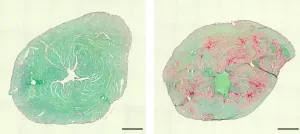Biodiversity 'hotspots' imperiled along California's streams
Intensive water management promotes 'live fast, die young' cycle in floodplain forests
2021-06-14
(Press-News.org) A study of woodland ecosystems that provide habitat for rare and endangered species along streams and rivers throughout California reveals that some of these ecologically important areas are inadvertently benefitting from water that humans are diverting for their own needs. Though it seems a short-term boon to these ecosystems, the artificial supply creates an unintended dependence on its bounty, threatens the long-term survival of natural communities and spotlights the need for changes in the way water is managed across the state.
"We need to be more intentional in incorporating ecosystem water needs when we manage water--both for aquatic organisms and species on land," said Melissa Rohde, the lead author of a study published June 14, 2021 in the Proceedings of the National Academy of Sciences (PNAS). "These forest ecosystems are in a precarious state because we have disrupted the natural hydrologic processes that these plant species rely upon to support and sustain key life processes."
In California's seasonally dry Mediterranean climate, plants and animals are adapted to rely on precipitation and soil moisture recharge during the rainy winter and spring seasons for reproduction and growth during the typically dry summers. Once soil moisture is exhausted, tree species often found in stream corridors such as willows, cottonwoods and oaks, typically use groundwater from deeper depths. However, as Rohde, who led the study as a Ph.D. candidate at the State University of New York College of Environmental Science and Forestry (ESF) and scientist with The Nature Conservancy of California, and her colleagues discovered, the story was more complicated.
By analyzing five years of vegetation greenness data from satellite imagery, the researchers found that in some cases, these ecosystems were affected by "subsidies of water" delivered via human regulation of rivers, agricultural canals and discharges from wastewater treatment plants. That discovery, Rohde said, was a "mind bender." Altered streamside woodlands in the most arid regions of the state stayed greener longer into the dry season and were less responsive to changes in groundwater levels than natural ecosystems.
Many of the most-altered stream ecosystems are in California's Central Valley, the state's agricultural hub, which produces a third of the produce for the United States. Since the Gold Rush in the 1850s, the massive human settlement that followed led to clearing of 95 percent of the natural floodplain woodlands across the region. These isolated and restricted riparian -- or streamside -- forests, now provide important habitat for threatened and endangered species..
As water is rerouted from rivers into canals to accommodate urbanization and the multibillion-dollar agricultural industry, it creates an artificially stable environment for riparian woodland ecosystems and a "live fast, die young" phenomenon favoring fast-growing trees that peak and then decline within a few decades. But other key ecosystem functions, such as the regeneration of new forest stands and their development over time, are being compromised by the extensive alterations to streamflow and to river channels, which are fixed in place and no longer create new floodplain areas where young trees can establish.
"We call these forests the 'living dead' because the forest floor is devoid of saplings and younger trees that can replace the mature trees when they die," Rohde said. This has repercussions related to habitat for endangered species, biodiversity, carbon sequestration and climate change.
Rohde said, "California is one of the most biodiverse regions in the world, containing more species than the rest of the United States and Canada combined. In the midst of the sixth mass extinction, the long-term sustainability of California's river ecosystems and the preservation of the rare and endemic species that live within them now rely on the deliberate, coordinated management of resource and government agencies." She and TNC will use the insights from the study to provide scientific guidance to California natural resource agencies for sustainably managing groundwater-dependent ecosystems throughout the state.
The research team conducted the PNAS study using publicly available online data and Google Earth Engine, an open-source tool for analyzing data from satellites and other global spatial datasets. "Our methods and findings open up a whole new world of interdisciplinary research possibilities and ways that water practitioners can consider ecosystem water needs to achieve sustainable water management," Rohde said.
John Stella, an ESF professor and Rohde's Ph.D. advisor, is the principal investigator on the National Science Foundation grant that funded the study. He said, "This work is groundbreaking because Melissa was able to combine several big datasets in an innovative way to understand how climate and water management interact to put these sensitive ecosystems at risk. Her findings are important for sustainably managing groundwater, not only throughout California, but in water-limited regions worldwide. By creatively harnessing and integrating these large environmental datasets, we can now answer resource management questions at a scale that was previously impossible."
INFORMATION:
Other collaborators and authors on the paper are Dar Roberts of the University of California at Santa Barbara (UCSB) and Michael Singer, who has an affiliation at UCSB and at Cardiff University in the United Kingdom. Stella noted that this study is part of a $2.5 million suite of projects that he and these collaborators at UCSB and Cardiff have currently funded throughout the U.S. Southwest and France to develop water stress indicators for dryland riparian forest ecosystems threatened by climate change and increasing human water demand.
[Attachments] See images for this press release:

ELSE PRESS RELEASES FROM THIS DATE:
2021-06-14
The concentration of potentially toxic metals is increasing in the population of the franciscana dolphin --a small cetacean, endemic from the Rio de la Plata and an endangered species-- according to a study led by a team of the Faculty of Biology and the Biodiversity Research Institute (IRBio), published in the journal Science of The Total Environment.
The impact of human activity in the region could be the cause for the increase of trace elements such as chromium, copper, iron and nickel in the dolphins' biological tissues, as stated in the study. The paper counts on the participation of members from the National History Museum of Uruguay, and is subsidized through a project of ...
2021-06-14
LAWRENCE -- The United States has the highest population of incarcerated citizens among developed nations. Every year, roughly 2 million women, the majority held in jails, leave incarceration. The COVID-19 pandemic hit jails and correctional facilities harder than almost any other societal setting. Many of the people leaving incarceration are returning to communities that were also disproportionately affected by the pandemic, yet many people in that population have expressed hesitancy to receive a COVID-19 vaccine.
New research from the University of Kansas found high rates of vaccine hesitancy among women transitioning from incarceration, due to a multitude ...
2021-06-14
Syracuse, N.Y. - A study of nearly 550 adults with intellectual and developmental disabilities receiving residential services in New York City found that age, larger residential settings, Down syndrome and chronic kidney disease were the most common risk factors for COVID-19 diagnosis, and heart disease was most associated with COVID-19 deaths.
The study, "Risk Factors Associated With COVID-19 Outcomes Among People With Intellectual and Developmental Disabilities Receiving Residential Services," was published June 8 by JAMA Network Open and provided the first evidence of the risk factors leading to COVID-19 diagnosis and death among people with IDD who receive residential services.
The study's findings suggest that ...
2021-06-14
Fully occupied intensive care units (ICUs). Physically and mentally exhausted health workers. Chaotically overcrowded hospitals. These and similar problems posed by the COVID-19 pandemic in Brazil have created ideal conditions for the emergence of Candida auris, a microorganism some are calling a "superfungus" because of the speed with which it has developed drug resistance.
The first two cases were confirmed in December 2020 at a hospital in Salvador (state of Bahia, Northeast Brazil), and are described in the Journal of Fungi by a group of researchers led by Arnaldo Colombo, head of the Special Mycology Laboratory at the Federal University of São Paulo (UNIFESP). The study was supported by São Paulo Research Foundation - FAPESP.
"Nine other C. auris patients ...
2021-06-14
TROY, N.Y. -- The future of quantum computing may depend on the further development and understanding of semiconductor materials known as transition metal dichalcogenides (TMDCs). These atomically thin materials develop unique and useful electrical, mechanical, and optical properties when they are manipulated by pressure, light, or temperature.
In research published today in Nature Communications, engineers from Rensselaer Polytechnic Institute demonstrated how, when the TMDC materials they make are stacked in a particular geometry, the interaction that occurs between particles gives researchers more control over the devices' properties. Specifically, the interaction between ...
2021-06-14
A discovery from researchers at the University of Illinois Chicago may lead to new treatments for individuals who suffer from alcohol use disorder and depression.
The study, "Transcriptomics identifies STAT3 as a key regulator of hippocampal gene expression and anhedonia during withdrawal from chronic alcohol exposure," is published in the journal Translational Psychiatry by researchers at UIC's Center for Alcohol Research in Epigenetics.
"During withdrawal from long-term alcohol use, people often suffer from depression, which may cause them to start drinking again as a way to self-medicate. If we ...
2021-06-14
The spin of the Milky Way's galactic bar, which is made up of billions of clustered stars, has slowed by about a quarter since its formation, according to a new study by researchers at University College London (UCL) and the University of Oxford.
For 30 years, astrophysicists have predicted such a slowdown, but this is the first time it has been measured.
The researchers say it gives a new type of insight into the nature of dark matter, which acts like a counterweight slowing the spin.
In the study, published in the Monthly Notices of the Royal Astronomical Society, researchers analysed Gaia space telescope observations of a large group of stars, the Hercules stream, which are in resonance with the bar - that is, they revolve around the galaxy ...
2021-06-14
An international team of researchers led by the University of Bonn (Germany) has identified the cause of a rare, severe muscle disease. According to these findings, a single spontaneously occurring mutation results in the muscle cells no longer being able to correctly break down defective proteins. As a result, the cells perish. The condition causes severe heart failure in children, accompanied by skeletal and respiratory muscle damage. Those affected rarely live beyond the age of 20. The study also highlights experimental approaches for potential treatment. Whether this hope will be fulfilled, however, will only become clear in a few years. The results are published in the journal Nature ...
2021-06-14
A funny thing happened on the way to discovering how zinc impacts kidney stones - two different theories emerged, each contradicting the other. One: Zinc stops the growth of the calcium oxalate crystals that make up the stones; and two: It alters the surfaces of crystals which encourages further growth. Now it can be told - both theories are correct as reported in the America Chemical Society journal Crystal Growth & Design by Jeffrey Rimer, Abraham E. Dukler Professor of Chemical and Biomolecular Engineering at the University of Houston, who conducted the first study to offer some resolution to the differing hypotheses.
"What we see with zinc is something ...
2021-06-14
Our ability to confront global crises, from pandemics to climate change, depends on how we interact and share information.
Social media and other forms of communication technology restructure these interactions in ways that have consequences. Unfortunately, we have little insight into whether these changes will bring about a healthy, sustainable and equitable world. As a result, researchers now say that the study of collective behavior must rise to a "crisis discipline," just like medicine, conservation and climate science have done, according to a new paper published June 14 in the Proceedings of the National Academy of ...
LAST 30 PRESS RELEASES:
[Press-News.org] Biodiversity 'hotspots' imperiled along California's streams
Intensive water management promotes 'live fast, die young' cycle in floodplain forests





